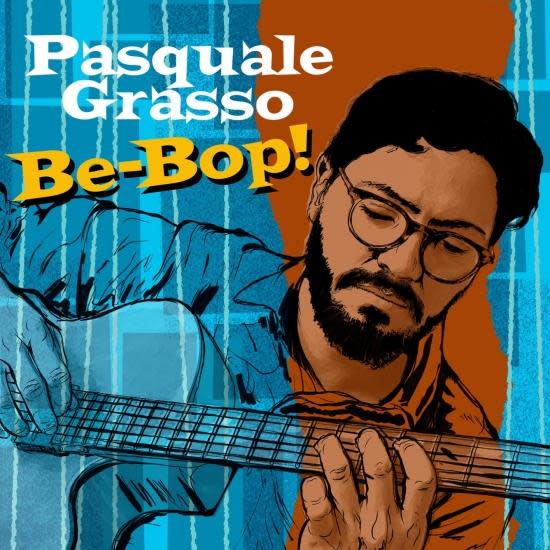Notes and tones: 'Be-Bop' showcases young guitarist's historic roots
- Oops!Something went wrong.Please try again later.
- Oops!Something went wrong.Please try again later.
- Oops!Something went wrong.Please try again later.
- Oops!Something went wrong.Please try again later.
- Oops!Something went wrong.Please try again later.

There’s something to be said when, in 2022, a guitarist born in 1988 in southern Italy releases a bass-and-drums trio recording titled “Be-Bop” (Sony Masterworks), housing 10 selections consisting primarily of Charlie Parker and Dizzy Gillespie compositions along with Thelonious Monk’s pensive, classically-introverted “Ruby, My Dear.”
For starters, if you are going to issue such an obviously-titled program, you best be an exceptional musician taking on repertoire that has certainly stood the test of time. You must have a whole lot of confidence when said material includes readings of Gillespie’s “A Night In Tunisia,” the title track and “Shaw ‘Nuff,” along with Bird mainstays such as “Cheryl,” “Ornithology” and “Quasimode.” We might as well throw in the closing selection, “Groovin’ High,” which Bird and Diz co-wrote.
Let’s say you are, in fact, uber-talented. You still have to answer a seminal question with such a release: How do you make the material your own, given that it’s been performed and recorded by everyone and their brother and sister for a half-century?
As it turns out, the answer is simple; all anyone has to do is hit play on Pasquale Grasso’s just-released “Be-Bop.” In some ways, as fellow guitarist Pat Metheny suggests in accompanying press materials: “What’s interesting about Pasquale is that he doesn’t sound anything like that at all. In a way, it is a little bit of a throwback, because his model — which is an incredible model to have — is Bud Powell.”
Interestingly enough, Grasso did not include any Powell — the penultimate bebop pianist — material on “Be-Bop.”
More to the point, Metheny notes, “He has somehow captured the essence of that language [transposing it] from piano onto guitar in a way that almost nobody has ever addressed. He’s the most significant new guy I’ve heard in many, many years.”
It’s certainly worth including praise from such a high-profile guitarist as Metheny in one’s press materials. But after carefully listening to “Be-Bop,” Metheny just might be on to something. Yes, virtually all the compositions are familiar enough as Grasso, heard here with his compatriots — bassist Ari Roland and drummer Keith Balla — rip through the material.
However, as they do, they pay distinct, careful attention to detail, distilling the essence of bebop harmonies along with the sub-genre’s other primary attributes — the ability to improvise on the one hand, and not lose the melody on the other.
So drenched in bebop is “Be-Bop” that “Lamento Della Campagna,” a slower, mostly unaccompanied piece, is the lone Grasso original contribution. Another track features up-and-coming vocalist Samara Joy, singing “I’m in a Mess” with the trio. At first I thought it was some kind of outlier — the only vocal track, more of a standard or show-tune, perhaps. However, after “asking the Google,” I discovered Gillespie released a version in 1951 — smack dab in the middle of the Bebop era.
Technically speaking, Grasso, all of 34, is a proverbial “monster” guitarist. He willingly admits being influenced by his heroes, but the transplanted New Yorker certainly adds tremendous fluidity and a distinctive flourish to his work — doing so without being overly flashy or gimmicky.
“Since I was a little kid,” says Grasso in the accompanying materials, “I was never too much influenced by guitar players. I grew up listening to Art Tatum, Bud Powell and Thelonious Monk. Those were my guys.
For guitar, I always liked Charlie Christian and Oscar Moore, but I never really listened to too much guitar players. Of course, when I hear Barney Kessel, Chuck Wayne and Jimmy Raney, I love them. They’re all great artists but they never really got me when I was a kid. I was more into Bird and Bud, Dizzy Gillespie, Roy Eldridge and Louis Armstrong. So, I was always more influenced by horn players and piano players than guitar players.”
If Grasso says that, it’s obviously fact. However, listening to him play throughout “Be-Bop,” you can hear other guitarists in his work and approach. At different intervals, you can hear the “Gypsy-styled” Django Reinhardt; and, as he notes, you also can’t miss Charlie Christian — which isn’t surprising, given that Christian helped develop bebop on the guitar.
Moving chronologically forward, there’s the unmistakable presence of Wes Montgomery, what with all the unison octaves heard throughout “Be-Bop”; finally, Grasso does dip into the modern mode, offering the kind of melodic density the late Pat Martino perfected.
Overall, Grasso’s “Be-Bop” offers great insight into a guitarist who has both absorbed the work of his elders and, like all exceptional jazz musicians, developed his own sound.
Jon W. Poses is executive director of the “We Always Swing” Jazz Series. Reach him at jazznbsbl@socket.net.
This article originally appeared on Columbia Daily Tribune: Notes and tones: 'Be-Bop' showcases young guitarist's historic roots
